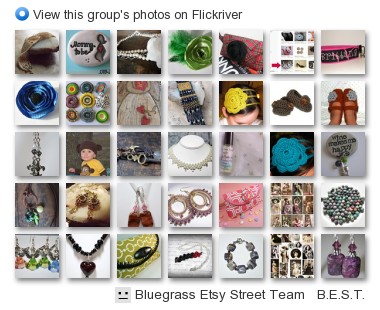
Today on Feature Friday, we focus on Jackie Alberti of
GloryBeHerbals. If you have been following the blog you will recognize Jackie's name from the Kentucky Wild Weeds articles that she writes for us. Now we learn a little more about Jackie and her love of plants, flowers and herbs.
How did you first hear about etsy? I first heard about etsy from another student in my herbal program.
Tell us about a little about yourself and your favorite craft/art! My favorite is aromatherapy but I also love herbs. I also knit and crochet when the urge strikes me but that's usually for family gifts.
 How did you get started as a designer?
How did you get started as a designer? I have always been interested in herbs. I seriously studied herbs and essential oils a few years ago because I was getting really concerned about how many chemicals my family is exposed to. I really believe that plants are God's gift to us and they can sometimes work in ways that pharmaceuticals can't. After I was using herbs and essential oils for a few months I realized how much better my stress levels were and I was off all my prescription meds, plus I wasn't having any of the nasty side effects. How great is that!
 What inspires you to create?
What inspires you to create? Sometimes it seems to come out of nowhere. Definitely a new herb or essential oil will inspire creativity. Sometimes I am trying to find a new protocol for a specific condition and I will be drawn to a certain plant or oil.
 How long have you been a member of Bluegrass etsy and how did you hear about the team?
How long have you been a member of Bluegrass etsy and how did you hear about the team? I have been on the team for about a year and a half now. I was invited to join not long after I signed up on etsy and I'm really glad I joined. We have really nice people and it's great to have a group supporting each other. BEST is a great team and I hope more members will be inspired to participate more. We have some members that are working SO HARD for the benefit of the whole team! If we could get half the team this passionate we probably could take over the world-or at least the state.
 Any advice you would give to aspiring designers?
Any advice you would give to aspiring designers? I think being an active member of a street team really helps with networking and morale. I also say keep on doing what makes you happy and listen to your customers.
 Anything else you would like to add?
Anything else you would like to add? Actually I have a new store for perfumery where I am using mainly fragrance oils plus some natural perfumes. It's at
JASaromatics if anyone would like to check it out. I also love to do custom work for customers-it challenges me in a great way.
*************
Thanks Jackie for the interview. In addition to Jackie's JASaromatics shop, you may also want to check out her
Glorybeherbals etsy shop!
To see more of the talented arts and crafts from Kentucky Handmade, go to
etsy.com and type in
teambluegrass in the search box.































